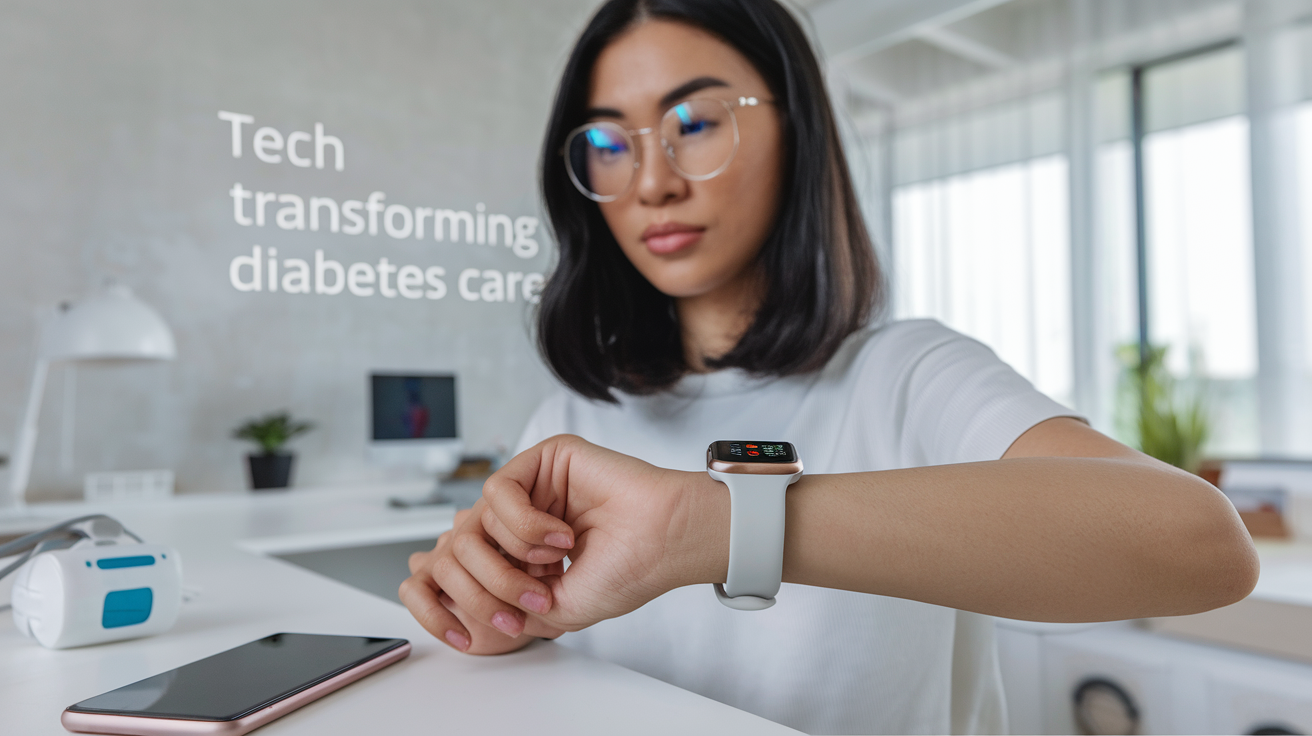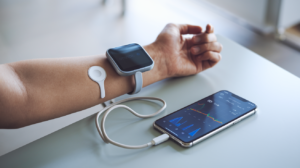Last Updated on March 13, 2025 by Alexander Sennuga
Living with diabetes has been a reality for millions of people with the medical condition for decades.
Imagine waking up every day knowing that your health depends on constant vigilance, precise measurements, and timely interventions. But what if technology could transform this daily struggle into a seamless, almost effortless routine? 🤔
The game is changing, and it’s changing fast. From continuous glucose monitors that whisper vital data to your smartphone to smart insulin pumps that think for themselves, technology is revolutionizing diabetes management. These innovations aren’t just gadgets; they’re lifelines that offer freedom, peace of mind, and unprecedented control over a condition that once dictated every aspect of daily life.
As we dive into the world of diabetes tech, we’ll explore how continuous glucose monitoring is eliminating finger pricks, how artificial intelligence is predicting blood sugar trends, and how telemedicine is bringing expert care right into patients’ living rooms.
Get ready to discover how these groundbreaking advancements are not just improving lives – they’re redefining what it means to live with diabetes. 🚀💉📱
Continuous Glucose Monitoring (CGM) Revolution
Real-time blood sugar tracking
Continuous Glucose Monitoring (CGM) has revolutionized diabetes management by providing real-time blood sugar tracking. Unlike traditional finger-prick methods, CGM devices offer a constant stream of glucose readings, typically updating every five minutes. This continuous data flow allows people with diabetes to make informed decisions about their diet, exercise, and medication throughout the day.
CGM systems consist of a small sensor inserted under the skin, usually on the abdomen or arm, which measures glucose levels in the interstitial fluid. The sensor communicates wirelessly with a transmitter that sends data to a receiver or smartphone app.
This seamless process enables users to view their glucose levels at any time without the need for manual testing.
Key benefits of real-time blood sugar tracking include:
- Immediate awareness of glucose fluctuations
- Ability to observe trends and patterns over time
- Reduced need for painful and inconvenient finger pricks
- Improved overall glycemic control
Predictive alerts for hypoglycemia
One of the most significant advancements in CGM technology is the ability to predict and alert users to potential hypoglycemic events. By analyzing glucose trends and rate of change, modern CGM systems can warn users about impending low blood sugar episodes before they occur.
These predictive alerts are crucial for preventing dangerous hypoglycemic events, especially during sleep or activities where regular monitoring might be challenging. Users can set customizable alert thresholds, allowing them to take proactive measures such as consuming carbohydrates or adjusting insulin doses to maintain safe glucose levels.
Data-driven insights for better management
CGM devices generate vast amounts of data, providing a comprehensive picture of an individual’s glucose patterns. This wealth of information enables both patients and healthcare providers to make data-driven decisions for improved diabetes management.
CGM data analysis can reveal:
- Patterns in glucose levels related to meals, exercise, and medication
- The impact of specific foods on blood sugar
- Effectiveness of insulin doses and timing
- Nighttime glucose trends and dawn phenomenon effects
By leveraging these insights, individuals can fine-tune their diabetes management strategies, leading to better overall glycemic control and reduced risk of complications.
Integration with smartphones for easy monitoring
The integration of CGM systems with smartphones has significantly enhanced the user experience and accessibility of glucose data. Most modern CGM devices can send data directly to smartphone apps, allowing users to view their glucose levels, trends, and alerts on their mobile devices.
This smartphone integration offers several advantages:
- Convenient access to glucose data anytime, anywhere
- Easy sharing of information with healthcare providers and caregivers
- Customizable alerts and notifications
- Integration with other health and fitness apps for a holistic approach to diabetes management.
As we move forward, the continuous advancements in CGM technology are paving the way for more intelligent and automated diabetes management systems. These innovations are not only improving the quality of life for people with diabetes but also opening up new possibilities for personalized treatment approaches.
Smart Insulin Delivery Systems
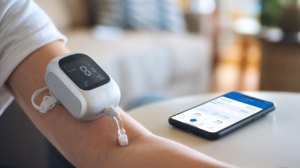
Automated insulin pumps
Automated insulin pumps represent a significant leap forward in diabetes management technology. These devices continuously deliver small doses of insulin throughout the day, mimicking the function of a healthy pancreas. Unlike traditional insulin injections, automated pumps provide a more precise and consistent insulin delivery, helping to maintain stable blood glucose levels.
Key benefits of automated insulin pumps include:
- Improved glucose control
- Reduced risk of hypoglycemia
- Greater flexibility in meal timing and food choices
- Fewer insulin injections
Closed-loop systems for precise dosing
Building upon automated insulin pumps, closed-loop systems take diabetes management to the next level. These systems, often referred to as “artificial pancreas” devices, combine continuous glucose monitoring (CGM) with an insulin pump to automatically adjust insulin delivery based on real-time glucose readings.
Closed-loop systems offer several advantages:
- Reduced mental burden for patients
- More accurate insulin dosing
- Better overnight glucose control
- Decreased risk of severe hypoglycemic events
Wearable patch pumps for convenience
Wearable patch pumps are revolutionizing insulin delivery by offering a more discreet and convenient option for people with diabetes. These small, lightweight devices adhere directly to the skin and deliver insulin without the need for tubing or a separate pump unit.
Patch pumps provide several benefits:
- Increased comfort and mobility
- Simplified insulin administration
- Improved adherence to insulin therapy
- Enhanced quality of life for users
Smartphone-controlled insulin delivery
The integration of smartphone technology with insulin delivery systems has opened up new possibilities for personalized diabetes management. Smartphone-controlled insulin delivery allows users to manage their insulin doses directly from their mobile devices, providing unprecedented convenience and control.
Key features of smartphone-controlled insulin delivery include:
- Remote bolus administration
- Real-time insulin delivery tracking
- Customizable insulin delivery profiles
- Integration with diabetes management apps
As we’ve seen, smart insulin delivery systems are transforming the landscape of diabetes care. These innovative technologies offer greater precision, convenience, and control for individuals managing their conditions.
With automated pumps, closed-loop systems, wearable patches, and smartphone integration, people with diabetes now have more options than ever to tailor their insulin therapy to their specific needs and lifestyles.
Next, we’ll explore how digital health platforms are further enhancing diabetes management by providing comprehensive tools for tracking, analyzing, and optimizing various aspects of diabetes care.
Digital Health Platforms for Diabetes Management
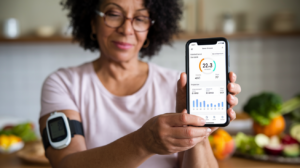
All-in-one apps for tracking diet, exercise, and medication
Digital health platforms have revolutionized diabetes management by offering comprehensive solutions in the palm of your hand. All-in-one apps have become indispensable tools for individuals living with diabetes, providing a centralized hub for tracking various aspects of their health and lifestyle.
These apps typically include features such as:
- Blood glucose logging
- Carbohydrate counting and meal planning
- Medication reminders and dosage tracking
- Exercise and physical activity monitoring
- Weight and blood pressure tracking
By integrating these functionalities, users can gain a holistic view of their diabetes management, making it easier to identify patterns and make informed decisions about their health.
Cloud-based data storage for easy access by healthcare providers
One of the most significant advantages of digital health platforms is the ability to store data securely in the cloud. This feature enables the seamless sharing of information between patients and their healthcare providers, enhancing the quality of care and facilitating more informed decision-making.
Cloud-based storage offers several benefits:
- Real-time data access for healthcare professionals
- Improved collaboration between patients and their care team
- Enhanced data security and backup
- Easier integration with electronic health records (EHRs)
With cloud-based storage, healthcare providers can access up-to-date information about their patients’ glucose levels, medication adherence, and lifestyle factors, allowing for more personalized and timely interventions.
AI-powered personalized treatment recommendations
Artificial intelligence (AI) is transforming diabetes management by analyzing vast amounts of data to provide personalized treatment recommendations. These AI-powered systems can identify patterns and trends that may not be immediately apparent to patients or healthcare providers.
AI algorithms can:
- Predict potential hypoglycemic or hyperglycemic events
- Suggest optimal insulin dosages based on individual responses
- Recommend dietary adjustments to improve glucose control
- Identify lifestyle factors that may be impacting blood sugar levels
By leveraging AI, digital health platforms can offer tailored advice and interventions, helping individuals with diabetes make more informed decisions about their health and potentially improving their overall outcomes.
Virtual coaching and support communities
Digital health platforms are not just about data tracking and analysis; they also provide valuable emotional and social support through virtual coaching and online communities. These features can be particularly beneficial for individuals who may feel isolated or overwhelmed by their diabetes management.
Virtual coaching often includes:
- Access to certified diabetes educators
- Personalized goal-setting and progress tracking
- Motivational support and encouragement
- Educational resources and tips for better diabetes management
Online support communities allow individuals with diabetes to connect with others facing similar challenges, share experiences, and offer mutual support. These communities can provide practical advice, emotional support, and motivation.
As we’ve seen, digital health platforms transform diabetes management by offering comprehensive tools, data-driven insights, and personalized support.
Next, we’ll explore how telemedicine and remote patient monitoring are further enhancing diabetes care, bringing expert medical advice and continuous oversight into the homes of individuals living with diabetes.
Telemedicine and Remote Patient Monitoring

Virtual consultations with diabetes specialists
Telemedicine has revolutionized the way people with diabetes interact with their healthcare providers. Virtual consultations offer a convenient and efficient way to connect with diabetes specialists without the need for in-person visits.
These online appointments allow patients to discuss their conditions, share recent health data, and receive expert advice from the comfort of their homes.
Key benefits of virtual consultations include:
- Increased accessibility to specialists, especially for those in rural areas
- Reduced travel time and associated costs
- More frequent check-ins, leading to better disease management
- Flexibility in scheduling appointments
Remote adjustment of treatment plans
With the integration of technology in diabetes care, healthcare providers can now remotely fine-tune treatment plans based on real-time patient data. This dynamic approach to diabetes management ensures that patients receive the most appropriate care without unnecessary delays.
Remote adjustments may include:
- Insulin dosage modifications
- Medication changes
- Dietary recommendations
- Exercise routine updates
This proactive method of care helps prevent complications and improves overall glycemic control.
Continuous data sharing with healthcare teams
The advent of connected devices and secure digital platforms has made it possible for patients to share their health data continuously with their care teams. This seamless flow of information provides healthcare professionals with a comprehensive view of the patient’s condition over time.
Shared data typically includes:
- Blood glucose readings
- Insulin doses administered
- Physical activity levels
- Dietary intake
By having access to this wealth of information, healthcare teams can make more informed decisions and provide personalized guidance to improve patient outcomes.
Early intervention based on real-time health metrics
One of the most significant advantages of remote patient monitoring in diabetes care is the ability to detect and address potential issues before they escalate. By analyzing real-time health metrics, healthcare providers can identify concerning trends or patterns that may require immediate attention.
Early intervention opportunities may arise from:
- Persistent high or low blood glucose readings
- Unexpected changes in insulin sensitivity
- Unusual patterns in physical activity or diet
- Signs of diabetes-related complications
This proactive approach to diabetes management can significantly reduce the risk of emergencies and hospitalizations, leading to better long-term health outcomes for patients.
As we move forward, the integration of telemedicine and remote patient monitoring in diabetes care continues to evolve, offering even more sophisticated tools for managing this complex condition. The next section will explore how advanced analytics and artificial intelligence are further enhancing diabetes care and treatment strategies.
Advanced Analytics and Artificial Intelligence
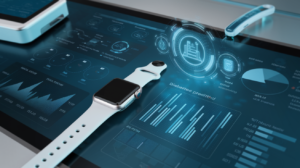
Predictive modeling for long-term health outcomes
Artificial intelligence and advanced analytics are revolutionizing diabetes management by providing powerful tools for predicting long-term health outcomes. These predictive models analyze vast amounts of patient data, including glucose levels, insulin intake, diet, exercise, and other health metrics, to forecast potential complications and health risks.
By leveraging machine learning algorithms, healthcare providers can identify patients at higher risk of developing diabetes-related complications such as cardiovascular disease, kidney problems, or neuropathy.
This proactive approach allows for early intervention and personalized treatment plans, potentially preventing or delaying the onset of these serious conditions.
Some key benefits of predictive modeling in diabetes care include:
- Early identification of high-risk patients
- Personalized risk assessments
- Improved treatment planning
- Better resource allocation for healthcare providers
- Enhanced patient engagement and motivation
Pattern recognition for personalized treatment strategies
Pattern recognition algorithms are transforming the way healthcare providers develop personalized treatment strategies for diabetes patients.
By analyzing data from continuous glucose monitoring (CGM) devices and other sources, these algorithms can identify unique patterns in each patient’s glucose fluctuations, insulin sensitivity, and lifestyle factors.
This deep understanding of individual patterns enables healthcare professionals to tailor treatment plans with unprecedented precision.
For example, the system might recognize that a patient’s blood sugar consistently spikes after consuming certain foods or during specific times of day, allowing for targeted adjustments in insulin dosing or dietary recommendations.
Machine learning algorithms for optimizing insulin dosages
One of the most exciting applications of AI in diabetes management is the optimization of insulin dosages. Machine learning algorithms can analyze a patient’s historical data, including glucose levels, insulin intake, meals, and physical activity, to predict future glucose trends and recommend precise insulin doses.
These algorithms continuously learn and adapt to each patient’s unique physiology and lifestyle, providing increasingly accurate dosing recommendations over time. This level of personalization can lead to:
- Better glucose control
- Reduced risk of hypoglycemia and hyperglycemia
- Improved quality of life for patients
- Less frequent need for manual dose adjustments
Big data analysis for population-level diabetes management insights
Beyond individual patient care, advanced analytics and AI also drive population-level insights in diabetes management. Researchers and healthcare organizations can uncover valuable trends and patterns that inform broader public health strategies by analyzing large datasets from diverse patient populations.
These population-level insights can help:
- Identify demographic groups at higher risk for diabetes complications
- Evaluate the effectiveness of different treatment approaches across various patient populations
- Guiding resource allocation for diabetes prevention and management programs
- Inform policy decisions related to diabetes care and public health initiatives
As we continue to harness the power of advanced analytics and artificial intelligence in diabetes care, we’re moving towards a future where treatment becomes increasingly personalized, proactive, and effective.
This technological revolution is not only improving individual patient outcomes but also reshaping our understanding of diabetes management on a global scale.
Emerging Technologies on the Horizon
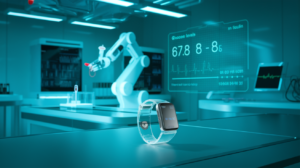
Non-invasive glucose monitoring devices
The future of diabetes management is moving towards less invasive and more convenient methods of glucose monitoring. Non-invasive glucose monitoring devices are at the forefront of this revolution, promising a pain-free alternative to traditional finger-prick tests.
These devices use various technologies to measure glucose levels without breaking the skin, including:
- Optical sensors that analyze light absorption through the skin
- Transdermal patches that extract interstitial fluid
- Radio wave technology to detect glucose concentrations
- Breath analysis devices that measure acetone levels
While still in development, these non-invasive methods could significantly improve the quality of life for people with diabetes by reducing discomfort and increasing adherence to regular monitoring.
Smart contact lenses for glucose measurement
Another exciting development in the realm of non-invasive glucose monitoring is the smart contact lens. These innovative devices are designed to measure glucose levels in tears, providing a continuous and discreet way to monitor blood sugar. The potential benefits of smart contact lenses include:
- Real-time glucose readings without the need for finger pricks
- Seamless integration into daily life
- Potential for early detection of dangerous glucose fluctuations
While challenges remain in perfecting this technology, it represents a promising avenue for future diabetes management.
Gene therapy approaches for diabetes treatment
Gene therapy offers a potential cure for diabetes by addressing the root cause of the disease. Researchers are exploring various gene therapy approaches, including:
- Modifying pancreatic cells to produce insulin
- Enhancing the body’s ability to regulate blood sugar
- Targeting genes responsible for insulin resistance
Although still in the early stages, gene therapy could revolutionize diabetes treatment by providing long-lasting or even permanent solutions.
Artificial pancreas systems
Artificial pancreas systems represent a significant leap forward in diabetes management. These closed-loop systems combine continuous glucose monitoring with automated insulin delivery, mimicking the function of a healthy pancreas. Advanced algorithms analyze real-time glucose data and adjust insulin dosage accordingly, offering:
- Improved glucose control
- Reduced risk of hypoglycemia and hyperglycemia
- Decreased mental burden for people with diabetes
As these systems continue to evolve, they promise to provide increasingly sophisticated and personalized diabetes management.
Nanotechnology for targeted drug delivery
Nanotechnology holds immense potential for revolutionizing diabetes treatment through targeted drug delivery. This cutting-edge approach involves using microscopic particles to deliver insulin or other medications directly to specific cells or tissues. The benefits of nanotechnology in diabetes care include:
- Enhanced drug efficacy
- Reduced side effects
- Potential for longer-lasting insulin formulations
As research in this field progresses, nanotechnology could lead to more effective and less invasive treatment options for people with diabetes.
These emerging technologies represent the next frontier in diabetes care, offering hope for improved management, reduced complications, and potentially even a cure. As we look to the future, it’s clear that technology will continue to play a crucial role in transforming the lives of people living with diabetes.
Conclusion
The rapid advancement of technology has significantly transformed the landscape of diabetes management, offering individuals with diabetes unprecedented control over their condition.
From continuous glucose monitoring systems that provide real-time data to smart insulin delivery devices that automate dosing, these innovations have revolutionized daily diabetes care. Digital health platforms and telemedicine services have further enhanced accessibility to medical expertise and personalized treatment plans.
As we look to the future, the integration of advanced analytics and artificial intelligence promises even more sophisticated tools for predicting and managing glucose levels. With emerging technologies on the horizon, the outlook for diabetes care is increasingly optimistic.
These technological strides not only improve the quality of life for those living with diabetes but also pave the way for more proactive, precise, and patient-centered healthcare. Embracing these innovations can lead to better outcomes, reduced complications, and ultimately, a world where diabetes is more manageable than ever before.

